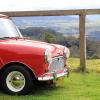Nope you have to measure the actual position at actual valve closure. It is significantly different to using the manufactures cam figures.
Assumption is the biggest killer of engines........
Ac
I can not see why the effective CR wouldn't be possible to calculate. Cam timings/crank stroke/rocker arm ratio should be according to specification (or?). To that the valve clearance need to be added. The rest is the same figures as for calculating static CR. The main uncertainty (as I see it) is the slack in the timing chain. Guide me. What is it that I am missing?

















